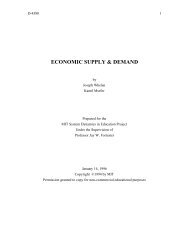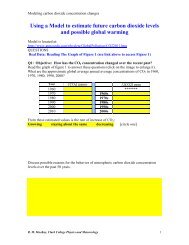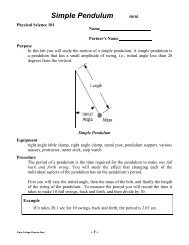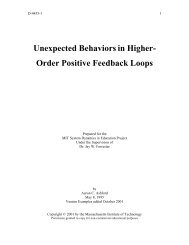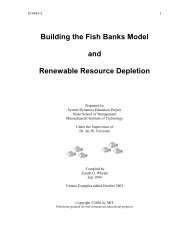Generic Structures First-Order Negative Feedback
Generic Structures: First order negative feedback loops
Generic Structures: First order negative feedback loops
You also want an ePaper? Increase the reach of your titles
YUMPU automatically turns print PDFs into web optimized ePapers that Google loves.
D-4475-2 1<strong>Generic</strong> <strong>Structures</strong>:<strong>First</strong>-<strong>Order</strong> <strong>Negative</strong> <strong>Feedback</strong>Produced for theSystem Dynamics in Education ProjectMIT System Dynamics GroupUnder the Supervision ofDr. Jay W. ForresterSloan School of ManagementMassachusetts Institute of TechnologybyStephanie AlbinSeptember 5, 1996Vensim Examples added October 2001Copyright © 2001 by the Massachusetts Institute of TechnologyPermission granted to copy for non-commercial educational purposes
2D-4475-2
D-4475-2 3Table of Contents1. INTRODUCTION 72. EXPONENTIAL DECAY 82.1 EXAMPLE 1: RADIOACTIVE DECAY 92.2 EXAMPLE 2: POPULATION-DEATH SYSTEM 102.3 EXAMPLE 3: COMPANY DOWNSIZING SYSTEM 103. THE GENERIC STRUCTURE 123.1 MODEL DIAGRAM 123.2 MODEL EQUATIONS 123.3 MODEL BEHAVIOR 154. BEHAVIORS PRODUCED BY THE GENERIC STRUCTURE 154.1 CHANGING THE INITIAL VALUE OF THE STOCK 154.2 CHANGING THE VALUE OF THE DRAINING FRACTION 164.3 CHANGING THE VALUE OF THE GOAL 185. SUMMARY OF IMPORTANT CHARACTERISTICS 196. USING INSIGHTS GAINED FROM THE GENERIC STRUCTURE 216.1 EXERCISE 1: RADIOACTIVE DECAY 216.2 EXERCISE 2: PACKAGE DELIVERIES 216.3 EXERCISE 3: COMPANY DOWNSIZING 227 SOLUTIONS TO EXERCISES 237.1 SOLUTION TO 6.1: RADIOACTIVE DECAY 237.2 SOLUTION TO 6.2: PACKAGE DELIVERIES SOLUTION 247.3 SOLUTION TO 6.3: COMPANY DOWNSIZING 248 APPENDIX 24SECTION 2.1: RADIOACTIVE DECAY MODEL DOCUMENTATION 24SECTION 2.2: POPULATION - DEATH SYSTEM MODEL DOCUMENTATION 25SECTION 2.3: COMPANY DOWNSIZING MODEL DOCUMENTATION 26
4D-4475-29 VENSIM EXAMPLES 27
D-4475-2 5
6D-4475-2
D-4475-2 71. Introduction<strong>Generic</strong> structures are relatively simple structures that recur in many diversesituations. In this paper, for example, the models of radioactive decay and a populationdeath system are shown to share the same basic structure! The transferability of structurebetween systems gives the study of generic structures its importance in system dynamics.Road Maps contains a series of papers on generic structures. These papers usegeneric structures to develop an understanding of the relationship between the structureand behavior of a system. Such an understanding should help refine intuition about thesystems that surround us and facilitate improvement of our ability to model behaviorsexhibited by systems.The knowledge about a generic structure in one system is transferable tounderstand the behavior of other systems that contain the same structure. Knowledge ofgeneric structures and the behaviors they produce is transferable to systems never studiedbefore!Behavior of a system is often more obvious than it's underlying structure. It iscommon practice to refer to systems by the behaviors they produce. However, it isincorrect to assume such systems are capable of exhibiting only their most popularbehaviors, and a need for a closer look at the other possible behaviors is present. A studyof generic structures examines the range of behaviors possible from particular structures.In each case, one seeks to understand what in the structure causes the behavior produced.This paper introduces a simple generic structure of first-order linear negativefeedback. Many examples of systems containing the basic generic structure illustrates thisstudy. Soon the structure will become recognizable in many new and different models.The exercises at the end of the paper provide an opportunity to transfer your knowledgebetween different systems.
8D-4475-22. Exponential DecayExponential decay is one of the behaviors commonly exhibited by a negativefeedback loop. Figure 1 contains a typical exponential decay curve. An importantcharacteristic of exponential decay is its asymptotic behavior. 1 The asymptote that thelevel approaches is the “goal” of the level. The goal is equal to zero in Figure 1. Anotherimportant characteristic of exponential decay is the curve’s constant halving time. Thehalving time is the time it takes for the stock to reduce by one-half. The following simpleformula approximates the halving time of a level using the time constant.The halving time = 0.7 * time constant.Remember, the time constant is the time in which the initial slope reaches the goal. Figure1 illustrates this concept. The time constant is 3 because the line tangent to the initialstock value crosses the time axis at 3 time units.1: STOCK1000.001halving time500.001goal ( = 0)0.00time constant0.00 3.00 6.00 9.00 12.00Time11Figure 1. Exponential Decay Curve1 A curve exhibiting asymptotic behavior gradually approaches a specific value (the asymptote) over time.The slope of the curve gets closer and closer to the slope of the line.
D-4475-2 9A simple negative feedback loop consists of a stock, an outflow from the stock,and a goal. The outflow is proportional to the difference between the stock and the goal.One can also refer to negative feedback loops as self-correcting or goal-seeking loops.For example, a radioactive element possesses a negative feedback structure and theresulting exponential decay. Another system with exponential decay arises from apopulation with no births or other inflows, and a death rate proportional to the population.Both of these systems share a common structure and exhibit similar behaviors. Anadditional system that exhibits exponential decay is a company that is downsizing it’swork-force to reach an explicit goal. These three systems share the basic negativefeedback structure with a goal (in some cases the goal is zero), and exhibit thecharacteristic behavior of exponential decay.These three systems mentioned above will now be explored in more detail.2.1 Example 1: Radioactive DecayFigure 2 shows radioactive decay. The stock represents an amount of aradioactive compound and the natural rate of decay of the compound into othercompounds is the outflow. The decay fraction is the fraction of the initial radioactivecompound that decays each time period and is characteristic of the specific compound.Assuming this is a closed system and there is no further addition of the radioactivecompound, eventually the entire initial amount will transform into a stable compound.The implicit goal of the level for the system is zero.The rate of decay = radioactive compound * decay fraction.radioactive compoundrate of decayFigure 2. Radioactive Decaydecay fraction
10D-4475-22.2 Example 2: Population-Death systemFigure 3 models the dynamics of a population of mules. The mule population isthe stock and the death rate is the outflow. The death fraction is the fraction of mulesthat die each year. The implicit goal of the mule system is zero. With no births in thesystem, the mules will eventually die out.The death rate = mule population * death fraction.mule populationdeath ratedeath fractionFigure 3. Population-Death systemExamples 1 and 2 both share the same underlying structure of a stock with anoutflow proportional to the stock. Both have an implicit goal of zero, which drives theexponential decay.2.3 Example 3: Company Downsizing SystemThe third example in Figure 4 shows a negative feedback structure with thenumber of employees in a company as the stock and the firing rate as the outflow.Instead of having an implicit goal of zero as in examples 1 and 2, the company’s goal isthe desired number of employees. The distance to goal is the difference between thelevel and the goal, and is simply the number of employees that the firm must reduce by toreach the goal. Thedistance to goal = number of employees – desired number of employees.
D-4475-2 11number of employeesfiring rateadjustment timedistance to goaldesired number of employeesFigure 4. Company Downsizing SystemThe firing rate decreases the stock of employees. The firing rate is the numberof employees fired per unit time, which is the same as the distance to goal spread outover the adjustment time Therefore, the firing rate is equal to the distance to goaldivided by the adjustment time.Firing rate = distance to goal/adjustment time.In the equation of the rate, there is division by the adjustment time, which is thetime constant of the system. Dividing by the adjustment time is analogous to multiplyingby a draining fraction as seen in examples 1 and 2. In the equation of the rate, multiplyingthe distance to goal by a draining fraction is identical to dividing by the time constant.The time constant is simply the reciprocal of the draining fraction.Example 3 has the same basic structure as examples 1 and 2. It is possible tomodel examples 1 and 2 in this way. They are just specific cases of the generic structurewhere the goal equals zero. If the desired number of employees equals zero, then thedistance to the goal would simply equal the number of employees. The new rate equationbecomes:firing rate = distance to goal/adjustment timefiring rate = (number of employees – desired number of employees) /adjustment timefiring rate = (number of employees – 0)/adjustment timefiring rate = number of employees/adjustment time
12D-4475-2This last equation uses the simpler structure of examples 1 and 2.3. The <strong>Generic</strong> StructureNow examine the generic structure of negative feedback systems used in all 3examples. <strong>First</strong>, a model of the generic structure will be presented. All 3 examples can bemodeled using the general form of the generic structure. Then, the model equations forboth cases — using a draining fraction or using a time constant — will be examined.Lastly, the characteristic behaviors of the model will be discussed.3.1 Model Diagramstockflowgoal for stockadjustment gapFigure 5. <strong>Generic</strong> Modeldraining fractionFigure 5 shows the generic structure of a negative feedback loop. This model ofthe generic structure can model examples 1, 2, and 3 as well as similar systems.3.2 Model EquationsThe equations for the generic structure arestock(t) = stock(t – dt) + ( – flow) * dtDOCUMENT: This is the stock of the system. It corresponds to the amount ofradioactive compound, the mule population, or the number of employees of a firm in theexamples above respectively.UNIT: unitsOUTFLOWS:
D-4475-2 13flow = adjustment gap * draining fractionDOCUMENT: The draining fraction and the value of the gap set the outflow to thestock. It corresponds to the decay rate, death rate, and firing rate in the above examples.UNIT: units/timeadjustment gap = stock – goal for stockDOCUMENT: The adjustment gap is the difference between the stock and the goal forthe stock. In the radioactive and population examples it is equal to the difference betweenthe stock and the implicit goal of zero, or simply the value of the stock. The adjustmentgap also corresponds to the distance to goal in the employee example.UNIT: unitsdraining fraction = a constantDOCUMENT: The draining fraction is the fraction of the gap (equal to the stock whenthe goal is zero) that is closed each time period. The draining fraction corresponds to thedecay fraction and the death fraction in the examples above.UNIT: 1/timegoal for stock = a constantDOCUMENT: This is the goal for the stock. The goal equals zero in the radioactivecompound and population systems, and corresponds to the desired number of employeesin example 3.UNIT: unitsNote: If we had a time constant instead of a draining fraction, the equation for the flowand the time constant would beflow = adjustment gap/time constantUNIT: units/timetime constant = a constant
14D-4475-2DOCUMENT: This is the time constant. It represents the adjustment time for the stock.UNIT: timeFrom the comparison of the two possible equations for the rate, we notice that themultiplier in the rate equation is given by 2multiplier in the rate equation ? draining fraction ?1time constant2 For a more in depth explanation of time constants see the paper Beginner Modeling Exercises Section 3:Mental Simulations of <strong>Negative</strong> <strong>Feedback</strong> by Helen Zhu. (D-4536)
D-4475-2 153.3 Model BehaviorThe characteristic feature of exponential decay is its constant halving time which isthe time for the gap to be cut in half. Because the draining fraction is constant at 0.2, thehalving time remains constant for the entire simulation of the model. In Figure 6, forexample, the initial stock is 100 and the goal is 50, making the gap equal to 50. It takesabout 3.5 years for the gap to be cut in half to 25 (stock = 75) and another 3.5 years forthe gap to be cut in half again to 12.5 (stock = 62.5)!1: STOCK 2: GOAL FOR STOCK100.001150.0012 2 2120.000.00 5.00 10.00 15.00 20.00TimeFigure 6. Results of Simulation4. Behaviors produced by the generic structureThe behavior produced by this structure will vary, depending on the values of threeparameters: the initial value of the stock, the goal, and the draining fraction.4.1 Changing the initial value of the stockThis section explores the effect of varying the initial stock value. In our genericmodel, the stock has initial values of -8000, -4000, 0, 4000, and 8000 for runs 1 through 5respectively. The goal is constant and zero, the draining fraction at 0.2.
16D-4475-21: STOCK 2: STOCK 3: STOCK 4: STOCK 5: STOCK8000.001210.00212 13 3 3 2435454455-8000.000.00 5.00 10.00 15.00 20.00TimeFigure 7. Simulation for different initial values of the stockFigure 7 shows that the stock will always asymptotically approach its goal (in thiscase equal to zero) whatever its initial value is. In 5 halving times, the stocks are all about97% of the way to their goal of zero.We can clearly see that a negative feedback loop creates goal-seeking behavior.The stock will always asymptotically try to reach the goal to be in a state of stableequilibrium. The generic structure of a first-order negative feedback loop can exhibitthree types of behavior: asymptotic (exponential) decay to equilibrium, steady state inequilibrium, and asymptotic growth to equilibrium.4.2 Changing the value of the draining fractionChanging the value of the draining fraction accelerates or retards the exponentialdecay of a system. To study this effect we will vary the draining fraction while keepingthe initial value of the stock constant at 8000 and the goal set to zero. The drainingfraction has values of 0, 0.1, 0.2, 0.3, and 0.4 for runs 1 through 5 respectively. Thechange of behavior of the stock due to varying the draining fraction is shown in Figure 8below.
D-4475-2 171: STOCK 2: STOCK 3: STOCK 4: STOCK 5: STOCK8000.001 1 1 1234000.00242325435430.005 4 50.00 5.00 10.00 15.00 20.00TimeFigure 8. Simulation for different values of the draining fractionNotice that when the draining fraction is equal to zero, the original level of thestock does not change. This is because the flow is equal to the draining fraction times thelevel. Zero multiplied by the stock creates a flow of zero. Also, the greater the value ofthe draining fraction, the faster the stock approaches equilibrium. A larger drainingfraction accelerates the exponential decay. An examination of the halving time equationfor different values of the time constant 3 can quantitatively verify that acceleration. Adraining fraction of 0.1 corresponds to a halving time of 7 time units. A draining fractionof 0.4 corresponds to a halving time of only 1.75 time units. (Note: For a negative initialvalue of the stock, the effect of the draining fraction on the asymptotic growth rate to thegoal is similar. In that case, the stock grows asymptotically. The larger the drainingfraction, the faster the stock grows.)3 Halving time = 0.7 * time constant = 0.7/draining fraction. For a more in-depth explanation see Zhu,Helen. Beginner Modeling Exercises 3: Mental Simulations of <strong>Negative</strong> <strong>Feedback</strong> (D-4536). January1996, MIT System Dynamics in Education Project
18D-4475-24.3 Changing the value of the goalChanging the goal for the stock also creates interesting behaviors. We are againkeeping the initial stock at 8000 and the draining fraction equal to 0.2. Values of the goalare 8000, 6000, 4000, 2000, and 0 for runs 1 through 5. Figure 9 shows the simulation fordifferent values of the goal. Though the stock never actually reaches the goal, after about5 halving times the stock is 97% of the way to the goal. All the different runs have thesame halving times and traverse this percentage of the gap at the same time.1: STOCK 2: STOCK 3: STOCK 4: STOCK 5: STOCK8000.001 1 1 123222434000.003354445550.000.00 5.00 10.00 15.00 20.00TimeFigure 9. Simulation for different values of the goal for the stock
D-4475-2 195. Summary of important characteristicsStructure:The loop is a negative feedback loop if the flow is specified as an outflow in themodel and the draining fraction is positive (or if the draining fraction is negative and theflow is specified as an inflow in the model). 4Behavior:Figure 10 contains a summary of the behaviors that the negative feedback loop canexhibit. Although negative feedback loops are best known for their exponential decay,they do exhibit other behaviors.The generic structure of a first-order negative loop can exhibit three types ofbehaviors: asymptotic decay to equilibrium, constant at equilibrium, and asymptoticgrowth to equilibrium. All three types of behavior are goal-seeking.The behavior of the stock is in italicsfor each combination of parametervalues.Stock(assume goal = 0)<strong>Negative</strong> Zero PositiveZeroequilibrium atequilibrium atequilibrium atDrainingneg. valuezeropos. valueFractionasymptoticasymptoticPositivegrowth toequilibrium atdecay toequilibriumzeroequilibriumFigure 10. Summary of the behavior of a negative feedback loop
20D-4475-24 Since STELLA specifies the outflow as negative in the equations of the stock, we will assume thedraining fraction must be positive. Therefore, the simplest negative feedback loop requires a positivedraining fraction for the outflow of the stock.
D-4475-2 21To sum up, asymptotic growth and decay require an initial value of the stock otherthan zero and have a constant halving time. The rate at which the decay occurs increaseswith the value of the draining fraction. If either the stock or the draining fraction is zero,the outflow is also zero and equilibrium exists.Look over Figure 10 and all the graphs of simulation included in the paper. When you feelconfident about your understanding of the behavior, you should go on to the exercises inthe next section.6. Using Insights gained from the generic structureWe have seen many examples of different systems, with both implicit and explicitgoals with the same basic structure. Now, we apply the insight we gained fromunderstanding the generic structure and its behavior to understand the behavior of othersystems.To do the exercises, you need not simulate the models; hand computation shouldsuffice. However, after answering the questions, we encourage you to build andexperiment with the models.6.1 Exercise 1: Radioactive DecayIn section 2.1 we introduced the simple structure of radioactive decay. Carbon-14decays into the stable element Nitrogen with a half-life of 5700 years.1. Using the above information, draw the stock and flow diagram of the decay of Carbon-14.2. What is the value of the time constant? the draining fraction?6.2 Exercise 2: Package DeliveriesBelow is a simple negative feedback system.
22D-4475-2packages to be delivereddelivery rateaverage delivery timeFigure 11. Package DeliveriesJay runs a delivery service. His average delivery time is 2 days. A computercompany, Nanosoft, just sent him 500 packages to deliver immediately. The morepackages Jay has to deliver, the more pressure he is under to deliver them.1. What is the time constant and halving time? Give their units. What are the units of thedelivery rate?2. What is the goal of the stock of this system?3. How much time will it take for 50% of the packages to be delivered? 75% of thepackages?6.3 Exercise 3: Company DownsizingNanosoft has been losing money due to the competition of rival Picosoft.Managers at Nanosoft decided that by cutting the number of employees from 20,000 to12,000 Nanosoft could save money and still maintain production levels. The total timeallotted for the downsizing is 7 years. (Since it takes 5 halving times to reach 97% of thegoal— close enough to consider the downsizing complete— the halving time is 1.4 yearslong and the time constant is 2 years.)number of employeesfiring ratedesired number of employeesdistance to goaladjustment time
D-4475-2 23Figure 12. Company Downsizing1. What is the draining fraction and the adjustment time? What is the halving time? Givetheir units.2. In 3 years, what is the approximate number of employees working at Nanosoft?3. Nanosoft decided they want exactly 16,000 employees working at the firm in 4 years.How can Nanosoft get this result by changing the adjustment time while keeping thedesired number of employees at 12,000?7 Solutions to exercises7.1 Solution to 6.1: Radioactive Decay1.Carbon14Nitrogenrate of decaydecay fraction or time constantWe have a set amount of Carbon-14 that does not grow,thus our stock has no inflows andone outflow for decay. Carbon-14 decays into Nitrogen, so the outflow from the Carbonstock is the inflow to the Nitrogen stock.2. The halving time of Carbon 14 is 5700 years.The time constant ? halving time/ 0.7 ? 5700/0.7 ? 8142.86 yearsThe draining fraction = 1/time constant = 1/8142.86 ? 0.000123(NOTE to advanced modelers: The reason we can model the system in such a way, isbecause the unit of the stock is atoms. The number of atoms in the system is conserved.Fifteen atoms of Carbon 14 will decay into 15 atoms of Nitrogen. Had we done theproblem with the units of the stock being grams, the system would not be valid. The mass
24D-4475-2would not be conserved since the Carbon-14 is losing a beta particle (mass) to theatmosphere which is outside of the system as we modeled it).7.2 Solution to 6.2: Package Deliveries Solution1. The time constant = 2 days. The halving time ? 0.7 x time constant ? (2)(0.7) ? 1.4daysThe units for the delivery rate are packages/day.2. The goal for the system is implicitly zero.3. For 50% (1 halving time) of the packages to be delivered, Jay takes 1.4 days. For 75%(2 halving times) of the packages to be delivered, Jay takes 2.8 days.7.3 Solution to 6.3: Company Downsizing1. The time constant = 2 years, which is the adjustment time. The draining fraction =1/time constant = 0.5.The halving time ? 0.7 x time constant = (0.7)(2) = 1.4 years.2. In 3 years about 2 halving times go by. In two halving times, about 75% of the initialgap is filled. 75% of 8000 is 6000, therefore (20,000 - 6,000 ) 14,000 employees are stillworking at Nanosoft.3. In 4 years, Nanosoft wants 4,000 workers fired. This is 50% of the gap and shouldtake 1 halving time. If 1 halving time = 4 years, the adjustment time ? halving time/ 0.7? 4/0.7 = 5.7 years. Nanosoft should increase the adjustment time to 5.7 years.8 AppendixModel Documentation for Sections 2.1 to 2.3Section 2.1: Radioactive Decay Model Documentationradioactive compound(t) = radioactive compound(t – dt) + (– rate of decay) * dtINIT radioactive compound = a constantDOCUMENT: This is the amount of radioactive compound present.
D-4475-2 25UNIT: atomsOUTFLOWS:rate of decay = radioactive compound * decay fractionDOCUMENT: This is the amount of radioactive compound that turns into a stablecompound per year.UNIT: atoms/yeardecay fraction = a constantDOCUMENT: This is the draining fraction of the negative feedback system.UNIT: 1/timeSection 2.2: Population-Death System Model Documentationmule population(t) = mule population(t – dt) + (– death rate) * dtINIT mule_population = a constantDOCUMENT: This is the number of live mules in the systemUNIT: mulesOUTFLOWS:death rate = mule population * death fractionDOCUMENT: This is the number of mules that die per year.UNIT: mule/yeardeath fraction = a constantDOCUMENT: This is the draining fraction of the negative feedback system.UNIT: 1/years
26D-4475-2Section 2.3: Company Downsizing Model Documentationnumber of employees(t) = number of employees(t – dt) + (– firing rate) * dtINIT number of employees = a constantDOCUMENT: This is the number of employee who work for the company.UNIT: employeeOUTFLOWS:firing rate = distance to goal/adjustment timeDOCUMENT: This is the number of employees who are fired per week.UNIT: employee/weekadjustment time = a constantDOCUMENT: This is the time constant of the system.UNIT: weekdesired number of employees = a constantDOCUMENT: This is the goal for the negative feedback system.UNIT: employeedistance to goal = number of employees – desired number of employeesDOCUMENT: This is the adjustment gap for the negative feedback system.UNIT: employee
D-4475-2 27Vensim Examples:<strong>Generic</strong> <strong>Structures</strong>: <strong>First</strong>-<strong>Order</strong> <strong>Negative</strong><strong>Feedback</strong>By Aaron DiamondOctober 20012.1 Example 1: Radioactive DecayRadioactiveCompoundrate of decayDECAY FRACTIONINITIAL RADIOACTIVE COMPOUNDFigure 13: Vensim Equivalent of Figure 2: Radioactive DecayDocumentation for Radioactive Decay model(1) DECAY FRACTION=a constantUnits: 1/yearThis is the draining fraction of the negative feedback system.(2) FINAL TIME = 100Units: YearThe final time for the simulation.(3) INITIAL RADIOACTIVE COMPOUND=a constantUnits: atoms(4) INITIAL TIME = 0Units: YearThe initial time for the simulation.(5) Radioactive Compound= INTEG (-rate of decay, INITIAL RADIOACTIVECOMPOUND)Units: atomsThis is the amount of radioactive compound present.
28D-4475-2(6) rate of decay=Radioactive Compound*DECAY FRACTIONUnits: atoms/yearThis is the amount of radioactive compound that turns into astable compound per year.(7) SAVEPER = TIME STEPUnits: MonthThe frequency with which output is stored.(8) TIME STEP = .0625Units: YearThe time step for the simulation.
D-4475-2 292.2 Example 2: Population-Death systemMule Populationdeath rateINITIAL MULE POPULATIONDEATH FRACTIONFigure 14: Vensim Equivalent of Figure 3: Population-Death systemDocumentation for Population-Death model(1) DEATH FRACTION=a constantUnits: 1/yearThis is the draining fraction of the negative feedback system.(2) death rate=Mule Population*DEATH FRACTIONUnits: mules/yearThis is the number of mules that die per year.(3) FINAL TIME = 100Units: yearThe final time for the simulation.(4) INITIAL MULE POPULATIONUnits: mules(5) INITIAL TIME = 0Units: yearThe initial time for the simulation.(6) Mule Population= INTEG (-death rate, INITIAL MULE POPULATION)Units: mulesThis is the number of live mules in the system.(7) SAVEPER = TIME STEPUnits: yearThe frequency with which output is stored.(8) TIME STEP = .0625Units: year
30D-4475-2The time step for the simulation.2.3 Example 3: Company Downsizing SystemINITIAL NUMBER OF EMLOYEESNumber ofEmployeesfiring ratedistance to goalADJUSTMENT TIMEDESIRED NUMBER OF EMPLOYEESFigure 15: Vensim Equivalent of Figure 4: Company Downsizing SystemDocumentation for Company Downsizing model(01) ADJUSTMENT TIME=a constantUnits: weekThis is the draining fraction of the negative feedback system.(02) DESIRED NUMBER OF EMPLOYEES=a constantUnits: employeeThis is the goal for the negative feedback system.(03) distance to goal=Number of Employees-DESIRED NUMBER OF EMPLOYEESUnits: employeeThis is the adjustment gap for the negative feedback system.(04) FINAL TIME = 20Units: weekThe final time for the simulation.(05) firing rate=distance to goal/ADJUSTMENT TIMEUnits: employee/weekThis is the number of employees who are fired per week.(06) INITIAL NUMBER OF EMPLOYEES=a constantUnits: employee(07) INITIAL TIME = 0Units: week
D-4475-2 31The initial time for the simulation.(08) Number of Employees= INTEG (-firing rate, INITIAL NUMBER OFEMPLOYEES)Units: employeeThis is the number of employees who work for the company.(09) SAVEPER = TIME STEPUnits: weekThe frequency with which output is stored.(10) TIME STEP = 0.0625Units: weekThe time step for the simulation.
32D-4475-23.1 Model DiagramStockINITIAL STOCKflowadjustment gapDRAINING FRACTIONGOAL FOR STOCKFigure 16: Vensim Equivalent of Figure 5: <strong>Generic</strong> ModelDocumentation for the <strong>Generic</strong> Model(01) adjustment gap=Stock-GOAL FOR STOCKUnits: unitsThe adjustment gap is the difference between the stock and thegoal for the stock. In the radioactive and population examplesit is equal to the difference between the stock and the implicitgoal of zero, or simply the value of the stock. The adjustmentgap also corresponds to the distance to goal in the employeeexample.(02) DRAINING FRACTION=a constantUnits: 1/timeThe draining fraction is the fraction of the gap (equal to thestock when the goal is zero) that is closed each time period.The draining fraction corresponds to the decay fraction and thedeath fraction in the examples above.(03) FINAL TIME = 100Units: timeThe final time for the simulation.(04) flow=adjustment gap*DRAINING FRACTIONUnits: units/timeThe draining fraction and the value fo the gap set the outflowto the stock. It corresponds to the decay rate, death rate, andfiring rate in the above examples.
D-4475-2 33(05) GOAL FOR STOCK=a constantUnits: unitsThis is the goal for the stock. The goal equals zero in theradioactive compound and population systems, and corresponds tothe desired number of employees in example 3.(06) INITIAL STOCK= a constantUnits: units(07) INITIAL TIME = 0Units: timeThe initial time for the simulation.(08) SAVEPER = TIME STEPUnits: timeThe frequency with which output is stored.(09) Stock= INTEG (-flow, INITIAL STOCK)Units: unitsThis is the stock of the system. It corresponds to the amount ofradioactive compound, the mule population, or the number ofemployees of a firm in the examples above respectively.(10) TIME STEP = 0.0625Units: timeThe time step for the simulation.
34D-4475-2100 unitsGraph of Initial Simulation75 units150 units2121225 units0 unitsStock:goal for stock:0 2 4 6 8 10 12 14 16 18 20Time1 112 22Figure 17: Vensim Equivalent of Figure 6: Results of SimulationunitsunitsGraph of Stock with Different INITIAL VALUES8,000 units2345123452 31451 2 3 4 5-8,000 unitsStock : Stock(0)=-8000Stock : Stock(0)=-4000Stock : Stock(0)=0Stock : Stock(0)=4000Stock : Stock(0)=800010 2 4 6 8 10 12 14 16 18 20Time (time)123451234512345unitsunitsunitsunitsunitsFigure18: Vensim Equivalent of Figure 7: Simulation for different INITIAL VALUES ofthe Stock
D-4475-2 35Graph of Stock with different DRAINING FRACTIONS8,000 units1231114520 unitsStock : currentStock : current1Stock : current2Stock : current3Stock : current4450 2 4 6 8 10 12 14 16 18 20Time (time)123432112233445 5 53452345unitsunitsunitsunitsunitsFigure 19: Vensim Equivalent of Figure 8: Simulation for different values of theDRAINING FRACTIONGraph of Stock with Different GOAL FOR STOCK Values8,000 units0 units1Stock : currentStock : current1Stock : current2Stock : current3Stock : current42340 2 4 6 8 10 12 14 16 18 20Time (time)1253451234152132435451123452345unitsunitsunitsunitsunits
36D-4475-2Figure 20: Vensim Equivalent of Figure 9: Simulation for different values of the GOALFOR STOCK




